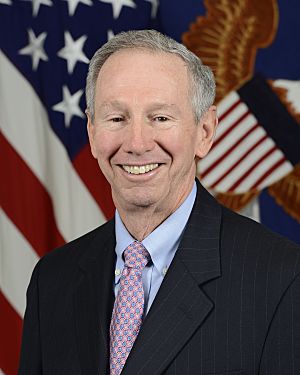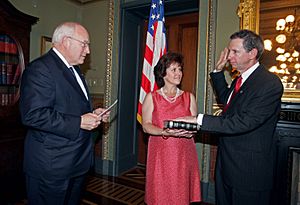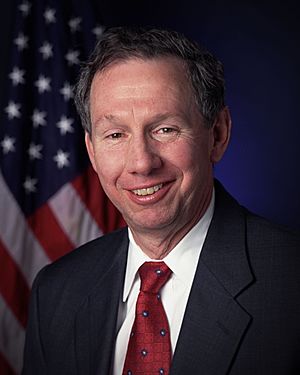Michael D. Griffin facts for kids
Quick facts for kids
Michael D. Griffin
|
|
|---|---|

Official portrait, 2018
|
|
| Under Secretary of Defense for Research and Engineering | |
| In office February 19, 2018 – July 10, 2020 |
|
| President | Donald Trump |
| Preceded by | Position established |
| Succeeded by | Heidi Shyu |
| 11th Administrator of the National Aeronautics and Space Administration | |
| In office April 13, 2005 – January 20, 2009 |
|
| President | George W. Bush |
| Deputy | Shana Dale |
| Preceded by | Sean O'Keefe |
| Succeeded by | Charles Bolden |
| Personal details | |
| Born |
Michael Douglas Griffin
November 1, 1949 Aberdeen, Maryland, U.S. |
| Education |
|
Michael Douglas Griffin, born on November 1, 1949, is an American physicist and aerospace engineer. He is a scientist who designs things that fly in space. From 2018 to 2020, he was the Under Secretary of Defense for Research and Engineering. This means he helped lead research and development for the U.S. military.
Before that, he was the head of NASA from 2005 to 2009. As NASA Administrator, he was in charge of important space projects. These included planning for future human spaceflight to Mars. He also looked at the future of the Hubble Space Telescope.
Even though he calls himself a "simple aerospace engineer," Griffin has held many important government jobs. In 2007, TIME magazine named him one of the 100 most influential people. His time as NASA Administrator brought big changes to the space agency.
Contents
Griffin's Work in Space and Defense
Griffin's career began in the 1980s at the APL. There, he helped design satellites for missile defense. These satellites were part of the Strategic Defense Initiative Organization (SDIO). He quickly became a leader in this area. He helped create the first time a missile was stopped in space while it was still flying.
In 1991, Griffin was the president of Orbital Sciences. This company built rockets for the government. They aimed to create low-cost rocket launchers. In September 1992, his company successfully sent a test probe to Mars.
In 2002, Griffin met Elon Musk. They traveled to Russia to try and buy ICBMs. On the flight home, they decided to start SpaceX. Griffin thought about being the chief engineer for SpaceX. Instead, he became president of In-Q-Tel. This company helps the CIA find new technologies for national security.
Leading NASA's Space Missions
In 2005, Griffin became the Administrator of NASA. He strongly supported using private companies for space travel. He wanted them to carry cargo and even astronauts into space. He started a program called Commercial Orbital Transportation Services (COTS). This program helped companies like SpaceX and his former company, Orbital Sciences, develop space transportation.
In 2008, NASA gave more contracts to SpaceX and Orbital Sciences. These contracts were worth $3.5 billion. Elon Musk later said these contracts helped save SpaceX from going out of business.
Defense Research and New Technologies
In 2018, Donald Trump appointed Griffin as Under Secretary of Defense for Research and Engineering. One of his first actions was to create the Space Development Agency. This agency's job was to build a network of satellites in low Earth orbit. These satellites would help detect new weapons from countries like China and Russia.
Companies like L3Harris and SpaceX (with its Starlink military satellites) received contracts for this project. The CIA Director called this project a "Strategic Defense Initiative for our time." Griffin also supported developing hypersonic weapons. These are very fast missiles that can glide through the air. In 2020, he said the U.S. would invest a lot in making these weapons.
Teaching and Other Roles
Before leading NASA, Griffin worked there as an associate administrator. He also taught at several universities. He taught courses on spacecraft design, math, and aerodynamics. He is also a pilot and owns a small airplane. In 2004, he became the head of the Space Department at Johns Hopkins University APL.
In 2023, Griffin joined the board of Castelion, a defense manufacturing company.
Education and Learning
Griffin has earned seven academic degrees during his career. He studied physics at Johns Hopkins University. He earned degrees in aerospace engineering from the Catholic University of America and the University of Maryland. He also studied electrical engineering at the University of Southern California. He has degrees in applied physics and civil engineering from Johns Hopkins University and George Washington University. He also earned an MBA from Loyola University Maryland.
In 2009, Griffin became a professor at the University of Alabama in Huntsville. He started a center there to study "systems thinking." This helps people understand how technology, nature, and people work together.
Vision for Space Exploration
In 2004, Griffin spoke to Congress about the future of human spaceflight. He said his main goal was for humans to settle the Solar System. He believed this was the only goal big enough to justify the hard work. He also supported powerful rockets and nuclear power for space.
Griffin shared that his love for space started at age five. He received a book about astronomy and space. From that moment, he knew he wanted to be a scientist or engineer in the space business.
Griffin has worked with many space groups. These include the National Space Society and the Mars Society.
- In 2004, he helped lead a study called "Extending Human Presence Into the Solar System." This study looked at sending humans to Mars.
- He was one of the first people to sign up for the Mars Society. This group wants humans to settle on Mars.
- In 2001, he spoke with Elon Musk at a Mars Society meeting. Musk announced his plan to grow plants on Mars there.
Leading NASA

On March 11, 2005, President George W. Bush chose Griffin to be the 11th Administrator of NASA. The Senate approved him on April 13, 2005. Vice President Dick Cheney officially swore him in. This showed how important NASA was to the Bush Administration.
In 2007, Griffin stated that NASA aimed to send a person to Mars by 2037.
In 2008, Griffin criticized the Space Shuttle program. He said that if the Apollo program had continued, humans could have been on Mars years ago. Instead, the focus shifted to the Shuttle and space station, which only reached Earth's orbit.
Challenges with NASA's Budget
Some groups criticized Griffin for moving money from science projects to human spaceflight. He had promised not to do this. But in 2006, NASA's budget for space research was cut by about 25%. This meant some planned programs were delayed. The reason was to fund Project Constellation, which was a top priority.
In 2005, funding for life science research was cut by 80%. This led to strong criticism from scientists. NASA centers focused on science also saw budget cuts. Griffin said these cuts were needed because of a $3.2 billion budget shortfall. The National Research Council agreed that NASA's total funding was not enough.
Finishing the International Space Station
President Bush's plan in 2004 said NASA had to finish building the International Space Station (ISS) by the end of 2010. This had to be done using the Space Shuttle. After the Columbia disaster, there were safety concerns. By June 2006, only one Shuttle flight had happened. Griffin decided that 18 more Space Shuttle flights were needed in the next four and a half years.
Griffin approved the launch of Space Shuttle Discovery in July 2006. This was the second mission after the Columbia disaster. He believed the risk was acceptable. This launch helped show that changes made to the external fuel tank were successful. The ISS was completed in early 2011, and the Space Shuttle was then retired.
Views on Climate Change
In 2007, Griffin made some comments about global warming. He said he had no doubt that global warming exists. However, he questioned if it was a problem that humans must fix. He wondered if the current climate was the "best" climate. He also said he didn't think humans could stop climate change.
Some climate scientists strongly disagreed with his comments. James E. Hansen, a top NASA climate scientist, called his remarks "arrogance and ignorance." Griffin later apologized for causing controversy. He said the issue had become more political than technical.
Leaving NASA
Griffin hoped to stay as NASA Administrator when Barack Obama became president. This would help keep NASA's programs on track. However, his resignation, which is standard for agency heads when a new president takes office, was accepted. This was partly due to disagreements about Project Constellation. Griffin gave a farewell speech in January 2009. He praised NASA for recovering from the Columbia disaster. He left office on the day President Obama was sworn in.
Later Career and Achievements
In 2009, Griffin became a professor at the University of Alabama in Huntsville. In 2010, a survey by the Space Foundation ranked him as the #7 most popular space hero.
In 2012, Griffin became chairman and CEO of Schafer Corporation. This company provides technology services to government and industry.
Return to Defense Leadership
In 2018, Griffin was confirmed as Under Secretary of Defense for Research and Engineering. He set technology priorities for the Department of Defense. In June 2020, Griffin announced he was leaving this position for a job in the private sector.
Rocket Lab
In August 2020, Griffin joined the board of directors at Rocket Lab. This company builds rockets and spacecraft. He left the board in September 2024.
Honors and Awards
Griffin has received many awards. These include the Defense Department's highest award for a non-government employee, the Distinguished Public Service Medal (1986). He also received the NASA Exceptional Achievement Medal (1994). In 2007, he received the Goddard Astronautics Award. Time Magazine named him one of the 100 Most Influential People in 2008.
In 2008, he was named the 74th Honorary Chancellor at Florida Southern College. In 2011, he received an honorary degree from the University of Notre Dame.
On July 11, 2018, an asteroid was named after him. It is called 159999 Michaelgriffin. An astronomer discovered this asteroid in 2006. In 2020, Michael Griffin was named an IEEE fellow.
See also
 In Spanish: Michael Griffin para niños
In Spanish: Michael Griffin para niños


